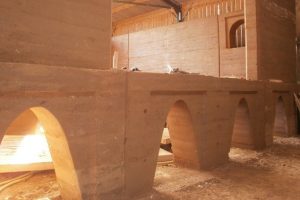
This paper assesses the suitability of two analytical and one numerical analysis techniques to determine the collapse load and the collapse mechanism of a rammed earth arch. The first method, based on thrust line analysis, is a graphic statics based approach that can predict collapse relying only on material properties of density and compressive strength, assuming that rammed earth has no tensile strength. The second method, limit state analysis, is based on a virtual work formulation to predict the collapse assuming the same set of material properties. Both analytical methods have been adapted from masonry analysis to take into account the limited compressive strength of rammed earth to better predict the rammed earth arch’s behavior and can be generalized to any material without tensile strength. The third method is based on a distinct element modeling technique. It is shown through a comparison with a load testing experiment of a 2 m span rammed earth arch that thrust line analysis is an excellent tool to predict the collapse load, but that it cannot provide decisive information regarding collapse mechanisms. Limit state analysis, in contrast, is very suitable to determine the collapse mechanism but may underestimate the ultimate load capacity if the location where cracks can form is not known in advance. Distinct element modeling can provide accurate information on both collapse mechanism and collapse load, but is more computationally demanding and requires a comprehensive characterization of material properties. The application of these techniques to rammed earth is motivated by the rise of the design of new arched and curved rammed earth structures, while appropriate analysis tools are lacking.